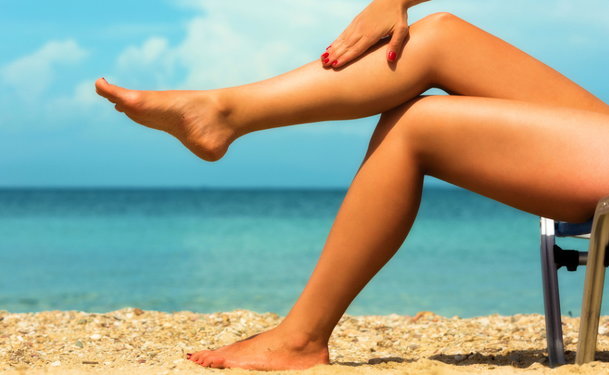Swimsuit season is quickly approaching—are your legs ready for summer? If you suffer from unsightly varicose veins or spider veins, you may be uncomfortable wearing shorts, skirts or swimsuits when you go outside. The good news is that several minimally-invasive treatments will help your legs look and feel better.
How are varicose and spider veins treated?
Compression stockings can help relieve the symptoms of varicose veins. They apply pressure to the legs to help push the blood toward the heart. However, these will not get rid of your varicose veins.
For that, you can turn to one of several treatments:
- Sclerotherapy. In this treatment for varicose and spider veins, your doctor will inject a liquid chemical or foam into the vein causing the walls of the vein to stick together and seal shut. Over time, the varicose vein will fade away.
- Endovenous thermal ablation. Vein specialists use endovenous thermal ablation (also called endovenous laser ablation of EVLT)to treat larger veins in the leg. In this procedure, your physician inserts a small catheter into the vein and then adds a probe into the catheter heating the varicose vein with radiofrequency or laser energy thus sealing the vein. Eventually, the varicose vein fades away.
- Surgery. While surgery is no longer the gold standard in treatment, it was for years, and some doctors still perform varicose vein surgery. Doctors turn to surgery to treat larger varicose veins. It may involve tying off the vein and removing it through small cuts in the skin (ligation and stripping). It may also include removing the varicose vein with a small hook through several cuts in the skin (ambulatory phlebectomy).
- Surface laser therapy. This treatment for spider veins uses an intense burst of focused light (laser) shone through the skin to heat the spider vein causing it to collapse and eventually disappear. Intense pulsed light (IPL) therapy is a similar treatment that uses less-focused light.
How long will it take to treat my varicose veins?
Treatments for varicose and spider veins are quick and involve little to no pain. However, it may take several weeks to months before your varicose veins disappear and you fully heal after treatment. For this reason, many seek treatment well before summer hits.
Here is a general recovery timeline for the different varicose vein treatments:
- Sclerotherapy. Veins will fade in several weeks. However, you may need several treatments spaced 4 to 6 weeks apart. Some veins may require more than one treatment.
- Surface laser therapy. Similar treatment time as sclerotherapy.
- Endovenous thermal ablation. The vein should start to fade right after treatment, but it can take four to six weeks to recover fully. You may also need sclerotherapy or surface laser therapy later on for smaller varicose or spider veins.
- Surgery. It will take around six weeks to recover from vein surgery. Also, you may need another procedure if the smaller varicose and spider veins don’t go away on their own after surgery.
What results should I expect after varicose vein treatment?
In most cases, varicose vein treatment will get rid of your problem veins. In some instances, varicose veins treated with sclerotherapy or endovenous thermal ablation will reopen later on. This is uncommon for spider and smaller varicose veins.
None of the treatments, though, will prevent new varicose or spider veins from forming.
What are varicose and spider veins?
Varicose veins appear as swollen, twisted veins beneath the surface of the skin. They can be red, blue or flesh-colored. They often show up on the inside of the leg, backs of the calves or thighs.
Spider veins are similar to varicose veins but are smaller and closer to the surface of the skin. They can appear blue or red, and look like spider webs or tree branches. They show up on the legs and face. They may cover a large area of skin or just a small part.
What causes varicose and spider veins?
Weak or damaged valves in the veins cause varicose veins. Damaged valves cause blood to flow backward in the vein, which causes it to pool and collect in the leg.
Sun exposure, injuries or changes in the hormones in the body can also contribute to the formation of spider veins.
Many factors increase your chance of getting varicose or spider veins, including:
- Increasing age
- Having family members who also have a vein problem
- Hormone changes that occur during pregnancy, puberty and menopause
- Pregnancy
- Obesity
- Sitting or standing for a long time
- Exposure to the sun—can cause spider veins on the nose or cheeks if you have fair skin
Updated Oct. 16, 2017


